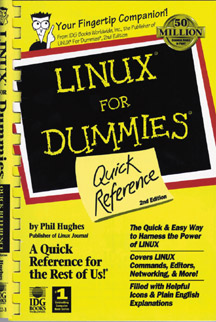

 |
 |

LINUX for Dummies Quick Reference fills you in on some of the basic capabilities of the Linux system, along with an assortment of those that aren't so widely used--commands and options you would discover only after years of experience using Linux.This quick reference is not a quick reference to Linux for Dummies but to the Linux system, so it is not organized in the same way. I'll try to summarize what is in it. There are ten parts, an appendix of on-line resources and a glossary. Part I, ``Getting to Know Linux'', covers what Linux is, selecting a Linux flavor, installing Linux, and fixing installation problems.Although this book isn't the whole story on Linux, I have tried to provide you with the most amount of useful information possible in a compact reference. For instance, descriptions of Linux commands include examples of their usage to illustrate how Linux syntax really works.
Part II, ``Understanding the Shell'', covers available shells, basic directory commands, character quoting, command history, customizing the environment, directory naming conventions, directory referencing, files associated with a program, file naming conventions, path names, shell command elements, shell variables, special characters and startup files.
Part III, ``Common Shell Commands'', covers commands for bash and/or the Korn shell but not csh, tcsh or any other shell. Luckily, most of the commands described are common to these shells.
Part IV, ``Using X/FVWM'', covers an introduction to X, the FVWM Desktop Anatomy, adding backgrounds, checking out programs under X, examining pull-down menus, exiting X, modifying window characteristics, mousing with X, moving around the screen, starting applications, starting X, switching tasks, using button bars and using keyboard shortcuts.
Part V, ``Text Editors and Working with Text'', covers the editors joe, Pico, Emacs, vi, spell-checking with ispell and formatting with fmt and groff.
Part VI, ``Sending and Receiving E-Mail'', covers understanding the pieces of an e-mail system, using Elm and Pine (the most popular screen-based e-mail programs), getting your e-mail remotely with POP and working with metamail files.
Part VII, ``Working with the Other Guys'', covers working with MS-DOS files and media and working with Macintosh media, working with UNIX files and media and converting data using Linux utilities.
Part VIII, ``Networking'', covers transferring files over a network, working interactively on remote machines and checking network connectivity.
Part IX, ``System Administration'', covers adding users and groups, connecting to an ISP with PPP, starting and stopping the system, kernel modules and performing system maintenance.
Part X, ``Using Regular Expressions'', covers understanding simple regular expressions and combining expressions, and looks at some examples.
A few awkward explanations I found while reviewing the first edition were corrected in this second edition, using my suggested phrasings. I have to admit I missed several other minor problems which I list below:
I expected the Quick Reference to be good because I have used some of the pocket references Phil Hughes wrote for SSC, and I wasn't disappointed. I let my wife, who uses an SGI machine at work, look at it and she concluded that this would be a good reference for UNIX generally, not just for Linux.
It has been my impression that any of the Dummies series of books should lead an uninformed user in a step-by-step didactic fashion, possibly using some humor to make difficult concepts more accessible. I think this is one of the better Dummies books, as it is factually correct and entertaining as well. Of course, those who grew up using a GUI and don't deal with command-line interfaces may have to wait for the video.
Harvey Friedman is a computer consultant at the University of Washington, functioning either as system administrator or statistical analyst. In his leisure time, he likes playing with Linux and enjoys orienteering, the sport of navigation. He can be reached via e-mail at fnharvey@u.washington.edu.